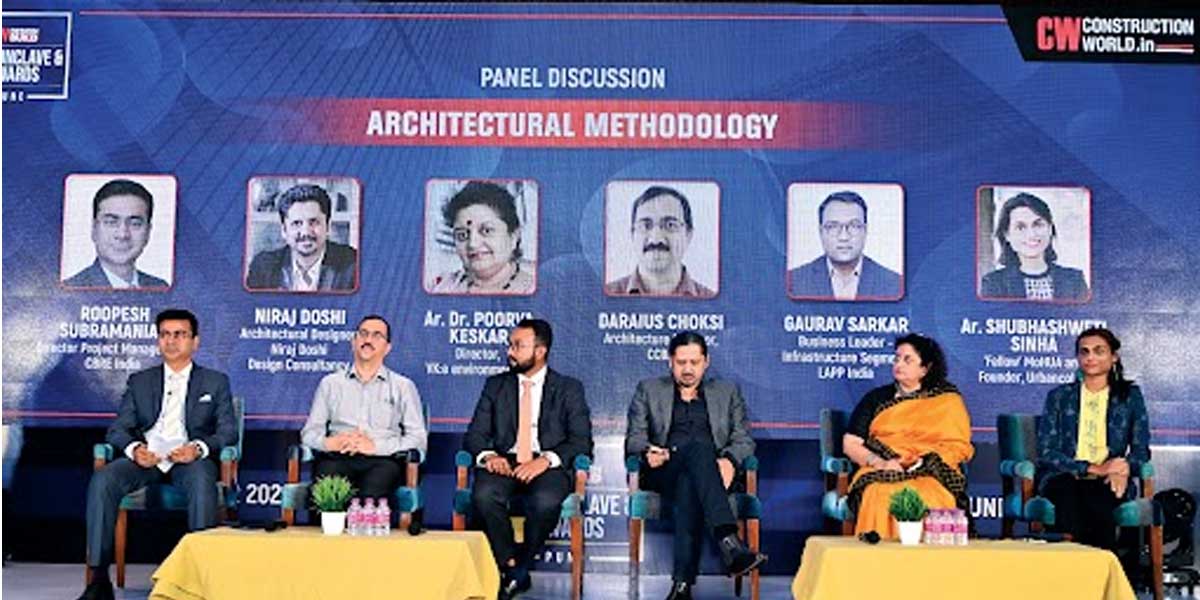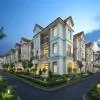After a terrific run in Ahmedabad, Bengaluru, New Delhi and most recently in Hyderabad, FIRST CONSTRUCTION COUNCIL with CW made its way to Pune for the CONSTRUCTION WORLD Design Build Conclave and Awards.
The event witnessed the creme de la creme of the real estate sector, architects, design firms and government officials under one roof. With two dynamic panel discussions, partner presentations, and keynote speeches; the event culminated with the ‘Stalwarts of the West-Pune’ awards.
Welcoming the dignitaries and a house full audience, Pratap Padode, Editor-in-Chief, CW, said, “Pune has a special place. It was one of the fast-moving cities when the Smart Cities Mission was announced. The city came up with plans at great pace and was right ahead in the race in terms of execution. In continuing the tradition of being the first, it has been announced that developers will not get a go-ahead on construction until they provide for recharging units of Electric Vehicles (EV). In terms of sales and supply of real estate, Pune has matched its supply with sales. There has been an equivalent effort to make sure that no inventory is left over.”
Further, Dr Sanjay Kolte, CEO, Pune Smart City, set the perfect tone for the evening. In his keynote address, Dr Kolte spoke on ‘Policy Intervention for Real Estate Development in the City’. He said, “The aspiration of the city and its citizens is to see Pune become smarter, safer, resilient, financially and environmentally sustainable, increasing inclusivity and ultimately making the city more liveable. It is heartening to note that Pune city received the ‘Most liveable city’ Ranking in 2018, followed by the second most liveable city ranking in 2021. The road re-redesign projects undertaken in Baner and Balewadi has been beneficial to the real estate development in the area. We should not forget that when we talk of smart cities and smarter real estate and construction, maximum use of modern technology and data-driven technology must be adopted so as to bring efficiency.”
In his keynote address, Atul Gadgil, Director (Works), Maha Metro, Pune, spoke on ‘Rewriting the real estate story with Metro’. He said, “Phase-I of the project has physically progressed to 80 per cent – 12 km out of 33 km is operational since March 2022, and the remaining is targeted to be operational by December 2023.” He added, “As we inch forward towards the completion of Phase-I, the Puneits in general and real estate industry in particular would benefit to a great extent by way of substantial increase in the economic activities within the influence area of the two corridors. And we are not stopping here! Government of Maharashtra has already entrusted us with the planning of phase-I extension of 10 km as well as 82 km of new lines, which will cover the growing and prospering localities of the outer areas of the city and connect with the existing metro corridors. When Phase-II gets completed, the city will have a network of about 125 km, which will contribute exponentially in its further development.”
Panel Discussion: Rethinking Architectural Methodology
Moderated by Roopesh Subramanian, Director Project Management, CBRE India, the panel consisted of Ar Daraius Choksi, Studio Director, CCBA Design; Gaurav Sarkar, Business Leader-Infrastructure segment, LAPP India; Niraj Doshi, Architectural Designer, Niraj Doshi Design Consultancy; Dr Poorva Keskar, Director, VK:e environmental; and Shubhashweti Sinha, Fellow, Ministry of Housing and Urban Affairs, Founder, UrbancoLab.
Key takeaways:Within the construction landscape, there appears to be a design revolution championed by the need to adopt new-age methods. This has encouraged the architects to rethink their strategies. Some of the imperative parameters including energy optimisation, health and wellness, comfort, and functionality are defining the buildings in the Indian real estate sector.
Whenever we try to rethink methodologies, it is a pause-and-reset button and that takes time. We need to rethink from the beginning, it is not only how we design and plan for the future, but how we integrate our buildings into the social and cultural fabric. Architecture is no longer a standalone profession. It's a symbiosis of various fields.There is a huge development in technology with AI, IoT, manufacturing processes like 3D printing, and new materials like foam concrete are encouraging architects to think out-of-the-box.
In the design process, we also need to look at how the architecture is interacting with the urban space. Certain old-age ideas can be reinvented to be sustainable. Another aspect that needs to be thought about is how it can be made affordable.
UDCPR in Pune has recognised the contribution that a green facility would give to not only the occupants but also the city. Incentives have been offered to build green spaces, like additional FSI. Funding agencies are now looking for resilient and sustainable funding.
Materials that can be recycled and upcycled have gained importance. The advantage this offers is two-fold – it is affordable and sustainable while also aesthetically pleasing.
There is a new technology primarily for commercial spaces, UVGI – Ultra-violet Germicidal Irradiation. This is mounted on the ceiling and emits UV rays that are not harmful to humans and disinfects the space up by about 90 per cent.
Pune has a lot of assets and the city has different areas that have different activities. For sustainable development, we need to have different solutions to suit the different contexts of the city.
Panel Discussion: Real Estate Market of Pune set to Boom
Moderated by Animesh Tripathi, Managing Director-Pune, Colliers, speakers on the panel included HS Anand, Chairman, Builders Association of India-Pune Centre; Rohit Gera, Managing Director, Gera Developments; Siddharth Vasudevan Murthy, Managing Director, Vascon Engineers; Vaibhav Manke, KAM Head, Panasonic Life Solutions; and Vaibhav Jatia, Managing Director, ResiTel.
Key takeaways:In the last 12 months, upwards of 100,000 homes were sold in Pune. Based on data, there are under 12 months of inventory overhang, which is a healthy place for the market to be in.
If you take inflation-adjusted and salary-adjusted numbers, affordability is sound, and hence, there is a clearly demand coming up. All this bodes well for the residential market. The only dark cloud we see is in the outcome of the state government’s policies on increasing FSI. Any landowner would previously think about 70,000-80,000 sq ft per acre; this has now gone up to 200,000 sq ft per acre. The potential supply just from a policy change is tremendous. The concern then comes, when we hit the over-supply situation.
Generally, industry bodies ask for incentives for themselves. It would be worthwhile to incentivise purchasers because that is where the cycle starts and you get more sales. Reduction in stamp duty and reduction in interest rates to the buyers can do a lot.For the timely delivery of projects, execution needs to be mechanised. Developers are now looking for well-mechanised contractors in order to meet RERA regulations and deadlines.
Mechanisation for a contractor can be looked at in three parts – in concreting with good boom placers and boom pumps; in steel with tower cranes and good processing machinery, and in cut-bend steel; most importantly, in formwork.
We have seen a lot of demand for green and ESG-compliant buildings, especially post-pandemic.
The only way to reach 5x or 10x times the FSI is to go vertical. Reaching 25-30 floors with conventional construction methods eats into the timeline. The extra 10-12 months absolutely kills the IRR, project returns, and inflation. Therefore, developers will be forced to go with contractors that have better mechanisation.
The awards
The event concluded with the CONSTRUCTION WORLD Design-Build Awards that honoured the ‘Stalwarts of the West-Pune’. Pesented by Dr Sanjay Kolte and Pratap Padode, the awards brought together architects, builders, contractors and developers to a common platform and awarded their noteworthy achievements.
The CONSTRUCTION WORLD Design-Build Conclave and Awards was Powered by Panasonic Life Solutions; with LAPP India and Tata Pravesh as Associate Partners; Rhythm ResiTel - Gold Partner; Builders Association of India - Association Partner and Housing.com as Knowledge Partner.




















